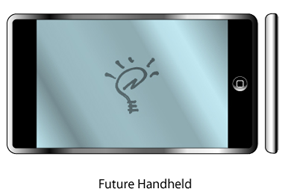August 9th, 2010

Before the iPad? The iBook tablet mod.
That was Jeff Paradiso’s idea:
Paradiso, a graphic designer from Boston, took a touch-screen iBook (an after-market modification from Troll Touch), disassembled it, cut a screen-sized hole in its lid, and flipped the screen around so that it faces outwards instead of towards the keyboard. Paradiso changed the desktop icons to large buttons and uses the operating system’s built-in, on-screen keyboard to get around.
After the Web Pad’s construction, Paradiso posted pictures of the iBook’s progress from weird, sturdy notebook to practical tablet.
It’s all a bit like Axiotron’s Modbook idea, except built in true DIY fashion. And it was from several years ago, when an iBook G3 was still a capable web-surfing, video-watching Mac. Today you’d have to do it with a Macbook.
Posted by davelawrence8 at 6:49 am on August 9th, 2010. Categories: ibook. Tags: G3, ibook, inkwell, mac, mod, pad, tablet, touchscreen. Subscribe via RSS.
June 9th, 2009

Lots of good stuff from Apple’s Worldwide Developer’s Conference (including a new iPhone 3GS), but the part that caught my eye was the ability of OS X 10.6 Snow Leopard to recognize Chinese symbols through handwriting recognition on Mac trackpads:
You can now use a Multi-Touch trackpad to draw Chinese characters in your documents. They’ll appear on the screen in a new input window, which recommends characters based on what you drew and lets you choose the right one. The input window even offers suggestions for subsequent characters based on what you chose.
The iPhone had this ability first, but now it’s an OS X-wide feature. Pretty cool.
Us Newton users are always curious to see how Apple uses handwriting recognition in our post-MessagePad world. The technology lives on in Inkwell, but would it be useful to have English handwriting recognition on Mac trackpads?
Posted by davelawrence8 at 6:54 am on June 9th, 2009. Categories: OS X. Tags: chinese, handwriting, hwr, inkwell, iphone 3GS, messagepad, newton, OS X, recognition, snow leopard. Subscribe via RSS.
July 16th, 2008

From Paul Potts, back in 1993:
Lewis Carroll’s famous poem, Jabberwocky, begins as follows:
`Twas brillig, and the slithy toves
Did gyre and gimble in the wabe:
All mimsy were the borogoves,
And the mome raths outgrabe.
This is fun nonsense, but interestingly, nonsense can teach us a bit about how the very first MessagePad’s handwriting recognition software works, by bringing about some “worst-case scenario” behavior. Handwriting recognition was one of the features of the original MessagePad that was perhaps too strongly hyped with respect to what it delivered, while the improved recognizers in later models never received the public credit they deserved.
Potts explains in this Folklore.org story how word lists and dictionaries can affect how the Newton translates handwriting. Interesting reading. And while you’re at it, check out the rest of Folklore – Andy Hertzfeld’s compendium of early Macintosh stories.
Posted by davelawrence8 at 7:34 am on July 16th, 2008. Categories: community, newton, newton history, software. Tags: apple, carroll, folklore, handwriting, inkwell, jabberwocky, messagepad, newton, recognition, rosetta. Subscribe via RSS.
May 7th, 2008

This isn’t the first time I’ve heard it (Ars Technica has it too), but it seems the beta of the new iPhone firmware offers some sort of handwriting recognition, at least for Chinese characters.
iPodHacks says many “consider Rosetta / Inkwell to be the most advanced handwriting recognition technology yet developed.” And I’ve heard that elsewhere too, since it’s – in part – derived from Newton’s own HWR engine.
I just bought a spare copy of OS X 10.2 Jaguar, and it reminded me that OS X ships with Inkwell. Could my suggestion of a Newton emulator on the iPhone be any easier now? Maybe it’s already done. But how would writing with your pinkie turn out?
Posted by davelawrence8 at 11:05 am on May 7th, 2008. Categories: ipod/iphone, OS X, rumors. Tags: character, chinese, emulator, handwriting, inkwell, iphone, ipod, jaguar, mac, OS X, rosetta. Subscribe via RSS.
April 10th, 2008

Check this out:
The Handwriting Recognition team is seeking an engineer who will be responsible for advancing Apple’s handwriting recognition technology for Mac OS X. The ideal candidate will be an expert in the area of pattern recognition, with an excellent understanding of handwriting recognition issues. The person will also assume primary responsibility for maintaining and enhancing existing code and tools. The recognition technology you create may extend beyond Mac OS X to other applications and the iPhone.
This is from Apple’s job site. Someone shared the post from Macrumors.com, who reminds us that “Rosetta technology has found its way into Mac OS X under the name ‘Inkwell,’ but requires a tablet to be installed for use.”
So what do you say? Got what it takes to invent the next Newton?
Posted by davelawrence8 at 1:15 am on April 10th, 2008. Categories: apple, rumors. Tags: apple, handwriting, inkwell, messagepad, newton, newton 2, recognition, rosetta, rumor, tablet. Subscribe via RSS.




